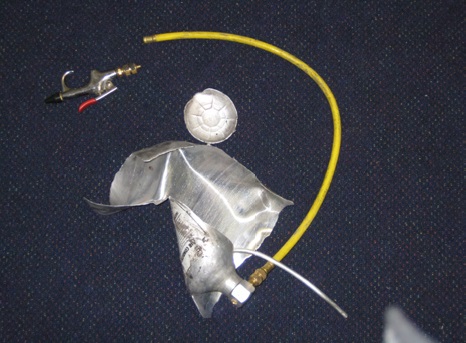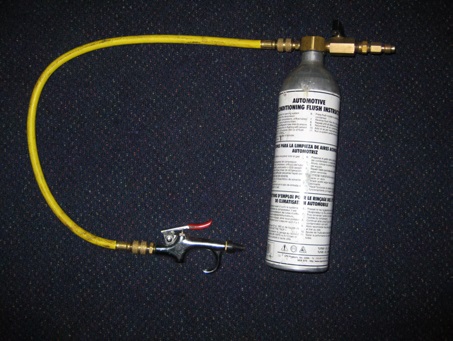
Mines safety alert no. 224 | 19 June 2009 | Version 1
Flushing canister bursts
Recommendations
- Flushing canisters should be fitted with an engineered pressure relief system, either from new, or prior to use on site.
- Where possible, avoid using high pressure gas sources for similar tasks; consider using air compressors fitted with delivery air filtration. Where this is not possible, ensure that delivery side regulator pressure can not exceed the safe working pressures of the components it supplies.
- The mine should establish the competencies required for air conditioning work and ensure this work is undertaken by competent people.
- When equipment to be pressurised comes to site, it must be scrutinised to ensure it is fit for purpose.
- Mines need to ascertain how similar tasks are conducted on site, identify the hazards associated with these tasks, and ensure they are appropriately controlled. (See Section 80, the Coal Mining Safety and Health Regulation 2001 and section 100, the Mining and Quarrying Safety and Health Regulation 2001)
Investigations are ongoing and further information may be published as it becomes available. The information in this publication is what is known at the time of writing.
We issue Safety Notices to draw attention to the occurrence of a serious incident, raise awareness of risks, and prompt assessment of your existing controls.
Mine Type
All mine types
Incidents
Incident 1
A fitter suffered deep lacerations to his upper legs, from groin to knee, when an aluminium flushing canister he was using burst. It is believed the catastrophic failure was due to over pressurising the canister, which was not fitted with a pressure relief valve.
The fitter was using the canister and flushing gun arrangement, which is supplied as a complete unit, to clean out the pressure and suction hoses on an air conditioning system that was fitted to a blast hole drill rig. The task was being conducted in a field maintenance situation.
The flushing canister is filled with a cleaning solvent. As pressurised gas is passed through the canister head, solvent is picked up and passed through a low pressure hose via a trigger operated delivery handpiece. The canister and gun unit has an instruction affixed which states that the unit should be connected to shop air at a pressure of six to10 Bar (90 to 150 psi).
In this instance the canister and gun unit was supplied pressurised gas from a nitrogen gas cylinder which has a nominal charge pressure of 16,300 KPa (2,300 psi). The cylinder was fitted with a pressure regulator, normally used to recharge accumulator components that may require pressures up to 16,000 KPa. At this time it is not known what pressure was being delivered through the regulator, as investigations are continuing to determine the pressure.
Incident 2
A contractor with 25 years experience on air conditioning systems was flushing out an air conditioning system on an integrated tool carrier vehicle. He was using an ERG Universal Flushing Agent. He had a hose connected from the nitrogen cylinder to his own low/high pressure gauge manifold. From the low pressure port a hose was connected to the flushing canister (1). There is a tap to control the output from the manifold. From the flushing canister, there was a hose to deliver the flushing agent into the air conditioning system. The rate of delivery was controlled by a trigger (2) at the end of the output hose.
By opening the tap on the low pressure side of the manifold with one hand, and holding the trigger open on the output hose from the flushing canister with the other hand, he flushed out the air conditioning system. As this process was almost complete, some flushing agent got into his eyes and he let go of the trigger holding the line open. This allowed pressure to build up in the flushing canister causing it to burst. The attachment of this hose (3) was ripped out of the canister.
Investigation showed that the regulator on the nitrogen cylinder was set at 1100psi and the flushing canister was rated at 150 psi. The mechanic received cuts to his neck and jaw requiring 20 stitches. He was wearing safety glasses.
Comment: It was the first time this flushing canister had been used. Previously a charge cylinder, with a safety valve, had been used, and the method of delivering the flushing liquid into the air conditioning system had evolved while the worker was using this charge cylinder.
Using nitrogen for delivering flushing agents into air conditioning systems is often the preferred option, increasingly so since the ban on releasing chlorofluorocarbons (CFC) into the atmosphere. The use of shop air, as the flushing canister instructions state, is not usually an option because the air may not be clean and the fitting on the canister input is flared not quick release.
The worker was an electrical fitter by trade and had a restricted air conditioning licence.
Equipment
Flushing canister and nitrogen bottle.
Hazard
Excessive pressure applied to flushing canister.
Cause
The flushing canister was over-pressurised.
Contact: minesafetyandhealth@dnrm.qld.gov.au
Issued by Queensland Department of Employment, Economic Development and Innovation
Find more safety notices
Search the hazards database


